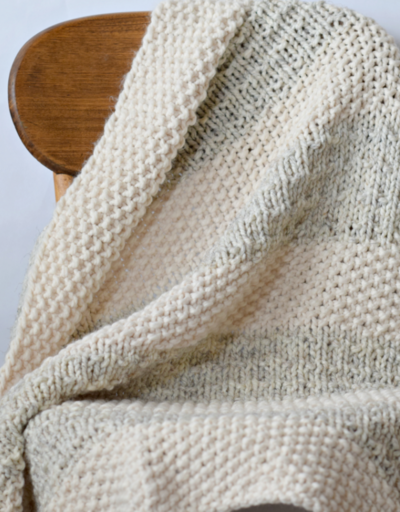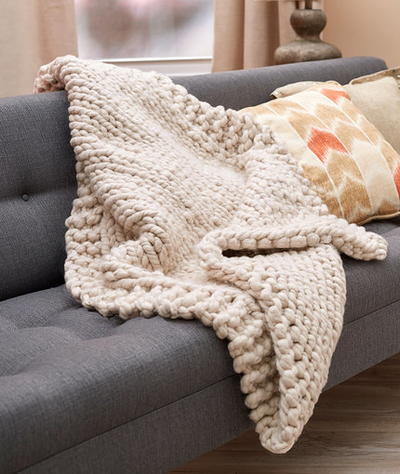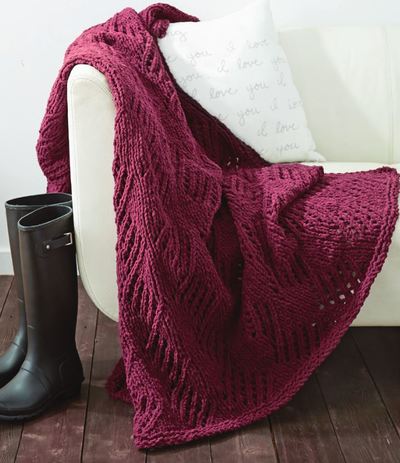Countryside Charm Afghan Pattern
This stunning knitted afghan pattern is great for when you want to show off beautiful yarns and color combinations!

Learning how to knit a blanket can often seem like such an impossible task, but it's not as bad as it seems. This pattern breaks the afghan knitting process into bite-sized pieces, which also makes this a great pattern for knitting on the go.
You don't have to be a professional knitter to take on the Countryside Charm Afghan. With the use of three basic knit stitches, this knit blanket pattern is a perfect for the beginner knitter looking for their first long-term knitting project. Wrap yourself in the warmth of this knit afghan or drape this beauty over your couch or bed to complement off the colors in the room.
Whichever you choose, this lovely Countryside Charm Afghan is sure to be a great addition to your home. Mix and match fun colors to create a beautiful color scheme that goes with your decor!

Knitting Needle Size9 or 5.5 mm, Circular Knitting Needles
Yarn Weight(4) Medium Weight/Worsted Weight and Aran (16-20 stitches to 4 inches)
Gauge16 sts and 22 rows = 4" [10 cm] in stockinette stitch
Finished SizeApprox 46½" x 64½" [118 x 164 cm]
Materials List
- Caron® United™ (4 oz/113 g; 235 yds/215 m) Contrast A Soft Grey Heather (06004) - 2 skeins; Contrast B Fresh Green (06012) - 5 skeins; Contrast C Aran (06002) - 5 skeins
- Size U.S. 9 (5.5 mm) knitting needles. Size U.S. 9 (5.5 mm) circular knitting needle 40” [100 cm] long or size needed to obtain gauge
Pattern
Stitch Instructions
Garter Slip Stitch Pattern
1st row: (RS). With Color 1, knit.
2nd row: With Color 1, knit.
3rd row: With Color 2, K1. *Sl1pwyb. K1. Rep from * to end of row.
4th row: With Color 2, K1. *yf. Sl1pwyf. yb. K1. Rep from * to end of row.
These 4 rows form Garter Slip Stitch Pat.
Moss Rib Pattern
1st row: (RS). P4. *K1. P1. K2. P3. Rep from * to end of row.
2nd row: K3. *P2. K1. P1. K3. Rep from * to last st. K1.
3rd row: P4. *K2. P1. K1. P3. Rep from * to end of row.
4th row: K3. *P1. K1. P2. K3. Rep from * to last st. K1.
These 4 rows form Moss Rib Pat.
Trinity Stitch Pattern
1st row: (RS). Purl.
2nd row: K1. *(K1. P1. K1) all in same st. P3tog. Rep from * to last st. K1.
3rd row: Purl.
4th row: K1. *P3tog. (K1. P1. K1) all in same st. Rep from * to last st. K1.
These 4 rows form Trinity Stitch Pat.
PANEL 1 (make 2):
With A, cast on 42 sts.
Proceed in Trinity Stitch Pat until work from beg measures 9” [23 cm], ending on a RS row. Break A.
Next row: (WS). With B, (P9. P2tog) 3 times. P9. 39 sts.
With B, proceed in Moss Rib Pat until work from beg measures 18” [45.5 cm], ending on a WS row.
With C as Color 1 and B as Color 2, proceed in Garter Slip Stitch Pat until work from beg measures 27” [68.5 cm], ending on a 1st row.
Next row: (WS). With C, P6. M1. (P13. M1) twice. P7. 42 sts.
With C, proceed in Trinity Stitch Pat until work from beg measures 36” [91.5 cm], ending on a RS row.
Next row: (WS). (P9. P2tog) 3 times. P9. 39 sts.
With C as Color 1 and B as Color 2, proceed in Garter Slip Stitch Pat until work from beg measures 45” [114.5 cm], ending on a 1st row. Break C.
Next row: (WS). With B, purl.
With B, proceed in Moss Rib Pat until work from beg measures 54” [137 cm], ending on a RS row. Break B.
Next row: (WS). With A, P6. M1. (P13. M1) twice. P7. 42 sts.
With A, proceed in Trinity Stitch Pat until work from beg measures 63” [160 cm], ending on a RS row.
Cast off (WS).
PANEL 2 (make 2):
With B, cast on 39 sts.
Proceed in Moss Rib Pat until work from beg measures 9” [23 cm], ending on a WS row.
With C as Color 1 and B as Color 2, proceed in Garter Slip Stitch Pat until work from beg measures 18” [45.5 cm], ending on a 1st row.
Next row: (WS). With C, P6. M1. (P13. M1) twice. P7. 42 sts.
With C, proceed in Trinity Stitch Pat until work from beg measures 27” [68.5 cm], ending on a RS row.
Next row: (WS). (P9. P2tog) 3 times. P9. 39 sts.
With B as Color 1 and A as Color 2, proceed in Garter Slip Stitch Pat until work from beg measures 36” [91.5 cm], ending on a 1st row. Break A and B.
Next row: (WS). With C, P6. M1. (P13. M1) twice. P7. 42 sts.
With C, proceed in Trinity Stitch Pat until work from beg measures 45” [114.5 cm], ending on a RS row.
Next row: (WS). (P9. P2tog) 3 times. P9. 39 sts.
With C as Color 1 and B as Color 2, proceed in Garter Slip Stitch Pat until work from beg measures 54” [137 cm], ending on a 1st row.
Next row: (WS). With B, purl.
With B, proceed in Moss Rib Pat until work from beg measures 63” [160 cm], ending on a RS row.
Cast off (WS).
PANEL 3 (make 1):
With C, cast on 39 sts.
With C as Color 1 and B as Color 2, proceed in Garter Slip Stitch Pat until work from beg measures 9” [23 cm], ending on a 1st row. Break B.
Next row: (WS). With C, P6. M1. (P13. M1) twice. P7. 42 sts.
With C, proceed in Trinity Stitch Pat until work from beg measures 18” [45.5 cm], ending on a RS row.
Next row: (WS). (P9. P2tog) 3 times. P9. 39 sts.
With B as Color 1 and C as Color 2, proceed in Garter Slip Stitch Pat until work from beg measures 27” [68.5 cm], ending on a 1st row. Break B and C.
Next row: (WS). With A, P6. M1. (P13. M1) twice. P7. 42 sts.
With A, proceed in Trinity Stitch Pat until work from beg measures 36” [91.5 cm], ending on a RS row. Break A.
Next row: (WS). With B, (P9. P2tog) 3 times. P9. 39 sts.
With B as Color 1 and C as Color 2, proceed in Garter Slip Stitch Pat until work from beg measures 45” [114.5 cm], ending on a 1st row. Break B.
Next row: (WS). With C, P6. M1. (P13. M1) twice. P7. 42 sts.
With C, proceed in Trinity Stitch Pat until work from beg measures 54” [137 cm], ending on a RS row.
Next row: (WS). (P9. P2tog) 3 times. P9. 39 sts.
With C as Color 1 and B as Color 2, proceed in Garter Slip Stitch Pat until work from beg measures 63” [160 cm], ending on a 1st row.
Cast off (WS)
FINISHING
Sew Panels tog in the following sequence:
1, 2, 3, 2, 1.
BORDERS
Side Borders: With RS facing, circular needle and B, pick up and knit 250 sts evenly across left side edge of Afghan. Do not join. Working back and forth across needle, knit 4 rows (garter st).
Cast off (WS).
Rep for opposite side.
Top and Bottom Borders: With RS facing, circular needle and B, pick up and knit 186 sts evenly across top edge of Afghan. Working back and forth across needle, knit 4 rows (garter st).
Cast off (WS).
Rep for bottom edge.
Abbreviations
- Approx.
- Approximately
- M1
- Make 1 stitch by picking up horizontal loop lying before next stitch and knitting into back of loop
- P2(3)tog
- Purl next 2 (3) stitches together
- Pat
- Pattern
- St(s)
- Stitch(es)
- Sl1pwyb
- Slip next stitch purlwise with yarn in back of work
- Sl1pwyf
- Slip next stitch purlwise with yarn in front of work
- Tog
- Together
Read NextSlip Stitch Sampler Afghan
Your Recently Viewed Projects
meo876 1636307
Dec 27, 2018
Looking at this pattern seems easy enough for the beginner knitter. However, I am not sure what you mean by pick up and knit...referring tho the border edges. Please explain or suggest a youtube site. thank you.
Lisa
Dec 27, 2020
Pick up and knit is a pretty common and standard knitting technique that most beginners are familiar with. It is a technique of picking up stitches along the edge of a knit piece, in order to continue knitting in a different direction. If you require a youtube to assist you, then it is on you to locate an adequate video for the technique.
Tricia108
May 29, 2018
I like the fact that they are not too many panels in this afghan. It is good for a beginner and also for someone like me who does not like to connect too many pieces. I will probably crochet an edging instead of picking up and knitting the edge.. It is a good stash buster as well as long as you coordinate the colors. Thank you for the pattern.
Mark
Jan 24, 2018
This is such a clever way to assemble a knitted blanket. Even if you don't follow this pattern exactly, creating it in panels is a great way to break it down.
judithkamykowski 8 090195
Sep 03, 2017
I tracked down the supposed errors in this pattern Panel 3 On the second garter slip stitch section, the pattern states With B as Color 1 and C as Color 2, proceed This should read With B as Color 1 and A as Color 2, proceed and Caron United (4 oz/113 g 235 yds/215 m) Contrast A Soft Grey Heather (06004) 2 skeins Contrast B Fresh Green (06012) 5 skeins Contrast C Aran (06002) 5 skeins Not really errors in the pattern itself. Good luck! Judy
watkinsgirl12000 5 000682
Jun 17, 2017
f there are mistakes pease tell me before i order the pattern peggy
tinachahal00 21363 68
Jun 20, 2016
I have just ordered the tarns on-line. Can't wait to start this project. I am fairly new to knitting and would really appreciate if anyone can advise of any changes to be made in terms of the pattern update. I will be gifting this to my daughter on her 25th birthday. Thanks
quanahs 5032097
Mar 09, 2016
While it may seem counter intuitive to start an afghan just as we approach warmer weather the small blocks used to create this afghan can be held in your hands without draping your lap in extra layers of warmth. The blocks can be assembled later in the year in time to gift that special person for Christmas. I love the color choices in your afghan haskinner100 55766 82, you did a great job.
haskinner100 55766 82
Nov 12, 2015
As a novice Ienjoyed making this blanket, even managed to make matching cushion covers!
Jernjen 4124906
Oct 28, 2015
like the previous comment--what mistakes did you find? I'm fairly new and probably will not discover it until it is to late and won't know how to fix it. Can't rate until I finish, but giving it a 4 on looks
Bettyblue1017 2616 019
Mar 14, 2015
Have you tried this craft? What did you think?
kmathison 5292272
Jun 19, 2015
I am making now and there are some mistakes in the pattern.
Susansgibayfield 8 213252
Sep 29, 2015
Was just going to start this pattern, what mistakes have you found
karenking2003 1403 953
Jan 02, 2018
I can't get the Trinity Stitch pattern to work at all. Have tried it 3 or 4 times now and can't get the 4th row to work out at all! There doesn't seem to be enough stitches left after the 2nd row
Lisa
Sep 19, 2018
The trinity stitch pattern is a 4 stitch repeat with 2 selvedge stitches, which makes the stitch count like this, 1 40 1= 42 sts, when you purl 3 together you are making 3 sts into 1 sts, then on the next stitch you are K1, P1, K1 all in the same stitch, so you are making 1 sts into 3 stitches, you will repeat these 2 steps 10X after the first selve stitch until the last selve stitch, giving you the original 42 sts that you cast on.
Report Inappropriate Comment
Are you sure you would like to report this comment? It will be flagged for our moderators to take action.
Thank you for taking the time to improve the content on our site.

















